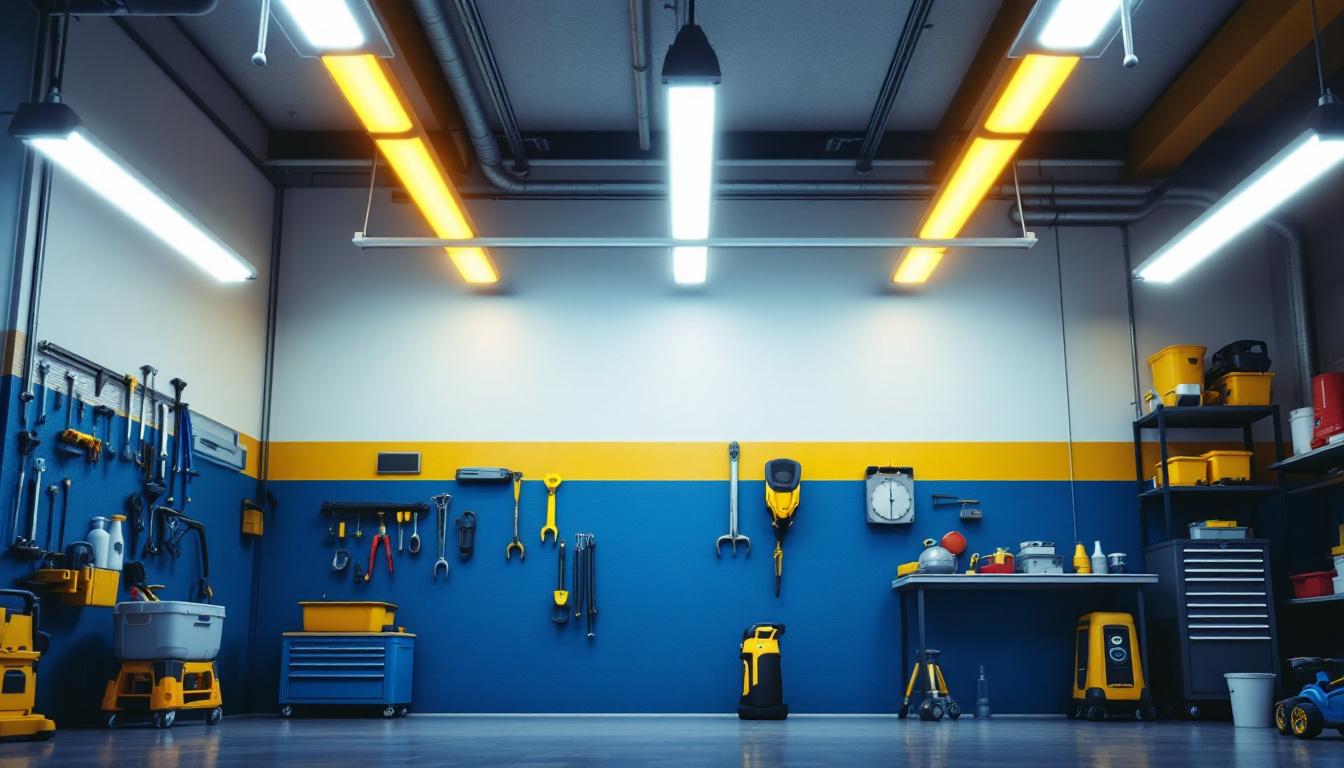
When it comes to illuminating a garage, the right lighting can make all the difference. For lighting contractors, understanding the nuances of garage LED lights is essential for delivering quality results to clients. This checklist serves as a comprehensive guide to ensure that every aspect of garage lighting is covered, from selecting the right fixtures to ensuring proper installation and maintenance.
Before diving into the specifics of LED lights, it’s crucial to assess the unique requirements of garage spaces. Garages often serve multiple purposes, from vehicle storage to workshops and recreational areas. Understanding these needs will help in selecting the most suitable lighting solutions.
The first step in planning garage lighting is to measure the dimensions of the space. This includes the height, width, and length of the garage. A larger garage may require more fixtures or higher lumen output to ensure adequate illumination. Conversely, smaller spaces might only need a few well-placed lights.
Additionally, consider the layout of the garage. Are there any obstructions, such as shelves or vehicles, that could block light? Mapping out these elements will help in determining the optimal placement for lights. Furthermore, the color of the walls and floor can significantly influence how light is perceived in the space. Light-colored surfaces will reflect more light, enhancing brightness, while darker surfaces may absorb light, requiring more powerful fixtures to achieve the desired illumination.
Next, consider how the garage will be used. Will it primarily serve as a storage area, or will it be a workspace for DIY projects? Different activities may require varying levels of brightness and light distribution. For example, a workshop might benefit from brighter, more focused lighting, while a storage area may only need ambient light.
Understanding these scenarios will guide the selection of fixtures and the overall lighting design. If your garage doubles as a recreational space, such as a home gym or a play area, you might want to incorporate adjustable lighting options. Dimmable lights can create a versatile environment, allowing for bright, energizing light during workouts or softer, more relaxed lighting for leisure activities. Additionally, consider integrating task lighting for specific work areas, such as under cabinets or above workbenches, to enhance visibility and safety during intricate tasks.
Once the needs of the garage have been assessed, it’s time to explore the different types of LED fixtures available. The right choice will depend on factors such as energy efficiency, brightness, and style. Selecting the appropriate lighting can significantly enhance the functionality of the space, making it not only more usable but also more enjoyable to spend time in.
There are several types of LED lights suitable for garage ceilings. Common options include:
Brightness is measured in lumens, and the required output will depend on the garage’s intended use. A general guideline is to aim for around 300-400 lumens per square meter for general lighting. However, workspaces may require brighter options, especially if intricate tasks such as woodworking or automotive repairs are performed. In such cases, opting for fixtures that provide 500-800 lumens per square meter can greatly improve visibility and reduce eye strain.
Color temperature is another critical factor. Measured in Kelvin, a range of 3000K to 5000K is usually ideal for garages. Warmer temperatures (around 3000K) create a cozy atmosphere, while cooler temperatures (5000K) mimic daylight, enhancing visibility for detailed tasks. Furthermore, some LED fixtures now offer adjustable color temperatures, allowing users to switch between warm and cool light depending on the time of day or the specific activity being undertaken. This flexibility can be particularly beneficial in multi-purpose garages, where lighting needs may vary significantly throughout the day.
Proper installation is vital for ensuring the longevity and effectiveness of garage lighting. Following best practices not only enhances safety but also maximizes the performance of the fixtures.
Before installing any lighting fixtures, it’s essential to evaluate the existing electrical system. Ensure that the circuit can handle the additional load from the new LED lights. If necessary, consult with a licensed electrician to upgrade the circuit or install new wiring.
Additionally, consider the placement of switches and dimmers. Installing switches near the garage entrance allows for easy access, while dimmers can provide flexibility in lighting levels based on the task at hand. This is particularly useful for those who use their garage for various activities, such as working on vehicles or engaging in hobbies, as it allows for a customizable lighting experience that can enhance visibility and comfort.
When installing LED lights, spacing is crucial for achieving uniform illumination. A common recommendation is to space fixtures approximately 8 to 10 feet apart, depending on the type of light and the height of the ceiling. For higher ceilings, consider using lights with a higher lumen output to ensure adequate brightness at ground level.
For areas with multiple uses, a combination of ambient and task lighting can be beneficial. This may involve using a mix of overhead lights and task-specific fixtures, such as under-shelf lighting in work areas. Additionally, consider the use of motion sensors for certain fixtures, which can enhance energy efficiency by ensuring lights are only on when the garage is in use. This not only saves on electricity costs but also extends the lifespan of the bulbs, making it a practical choice for those who may forget to turn off lights after their activities.
Furthermore, the color temperature of the lighting can significantly impact the functionality of the garage space. Warmer tones can create a cozy atmosphere, while cooler tones are often preferred for detailed work, as they mimic daylight and enhance visibility. Selecting the right color temperature can make a substantial difference in how tasks are performed, especially in areas where precision is key, such as during automotive repairs or woodworking projects.
Dust and debris can accumulate on light fixtures, diminishing their effectiveness. Regularly cleaning the fixtures with a soft cloth can help maintain brightness and clarity. For hard-to-reach areas, consider using a vacuum with a brush attachment to remove dust without damaging the lights.
Keep an eye on the performance of the lights. If any fixtures begin to flicker or dim, it may indicate a problem with the bulb or the electrical connection. Addressing these issues promptly can prevent further complications and ensure consistent lighting quality.
In today’s environmentally conscious world, energy efficiency is a top priority for many clients. LED lights are inherently more energy-efficient than traditional incandescent or fluorescent bulbs, but there are additional steps contractors can take to enhance sustainability.
Incorporating smart technology into garage lighting can significantly improve energy efficiency. Smart LED bulbs can be controlled via smartphone apps, allowing users to schedule lighting, adjust brightness, and even change color temperatures based on their needs.
Motion sensors are another excellent addition. These devices automatically turn lights on when someone enters the garage and off when the space is empty, reducing unnecessary energy consumption.
Educating clients about the benefits of energy-efficient lighting can help them make informed decisions. Providing information on potential energy savings, reduced electricity bills, and the environmental impact of their choices can lead to more sustainable lighting solutions.
Ensuring that all installations comply with local building codes and safety standards is a critical aspect of any lighting project. Failing to adhere to these regulations can lead to safety hazards and legal issues.
Before beginning any installation, familiarize yourself with local electrical codes and regulations. This may include specific requirements for wiring, fixture types, and placement. Consulting with local authorities or a licensed electrician can provide clarity on these standards.
Safety should always be a priority during installation. Use appropriate personal protective equipment (PPE), such as gloves and safety glasses, and ensure that the power is turned off before beginning any work. Additionally, using ladders safely and securing all tools can prevent accidents on the job site.
In conclusion, providing quality garage LED lighting solutions requires a thorough understanding of the space, careful selection of fixtures, and adherence to best practices in installation and maintenance. By following this checklist, lighting contractors can ensure they meet their clients’ needs while delivering efficient, effective, and safe lighting solutions.
Staying informed about trends in lighting technology and energy efficiency will further enhance the services offered. As the demand for sustainable and innovative lighting solutions continues to grow, contractors who prioritize these aspects will stand out in a competitive market.
Ultimately, the goal is to create a well-lit, functional garage space that enhances the user experience, whether for storage, work, or leisure. By focusing on quality and safety, contractors can build a reputation for excellence in garage lighting installations.
Ready to elevate your garage lighting installations with the best in LED technology? Look no further than LumenWholesale, where we specialize in providing contractors with high-quality, specification-grade lighting products at unbeatable wholesale prices. Our extensive selection not only meets but exceeds industry standards, ensuring your projects shine with reliability and performance. Say goodbye to middleman markups and hello to hassle-free bulk buying with free shipping. Don’t compromise on quality or value—visit LumenWholesale today and discover the perfect blend of quality, affordability, and convenience for all your lighting needs.

Discover the history of LED lights and learn how embracing this innovative technology can transform your lighting contracting business.

Discover how path lamps can transform your lighting projects and give you a competitive edge in securing more contracts.

Discover the evolution of LED manufacturing and its transformative impact on the lighting industry.

Discover how commercial exit signs can transform your lighting designs with enhanced safety and aesthetic appeal.